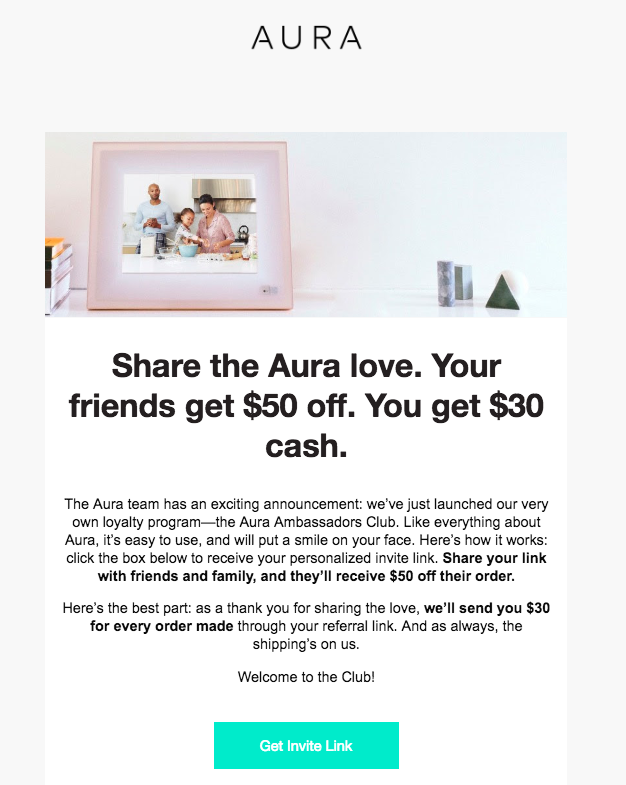What Is a Referral Program: A Guide to Building Your Own

Referral programs are an effective marketing tactic for many online stores. They help reach more people, generate new leads, and increase sales online.
One of the best referral programs comes from TheSkimm. This news company now serves seven million people, and 10% of the sign-ups come from their customer referral program. Dropbox also has a referral program that grew its conversion rates by 3900% in 15 months.
With proper steps, this word-of-mouth strategy can help businesses of all sizes and industries.
This tutorial will cover everything you need to know about referral programs, from the definition and benefits to referral program examples. We’ll also explain a step-by-step process to create a referral program, including tips, ideas, and recommended software.

What Is a Referral Program?
A referral program refers to a word-of-mouth marketing strategy encouraging existing customers to recommend a brand’s products to their network. Through the program, customers are incentivized with referral rewards, like discounts and free products.
How Does a Referral Marketing Program Work?
A referral program refers to asking happy customers to become brand advocates. They join a referral campaign and get a unique referral link or a code to share with their network.
Typically, the existing customers receive referral incentives once their referred customers purchase an item using the link or code.
For example, Casper’s refer-a-friend program offers a $10 Amazon gift card when a referred customer’s friend purchases its mattress for the first time.
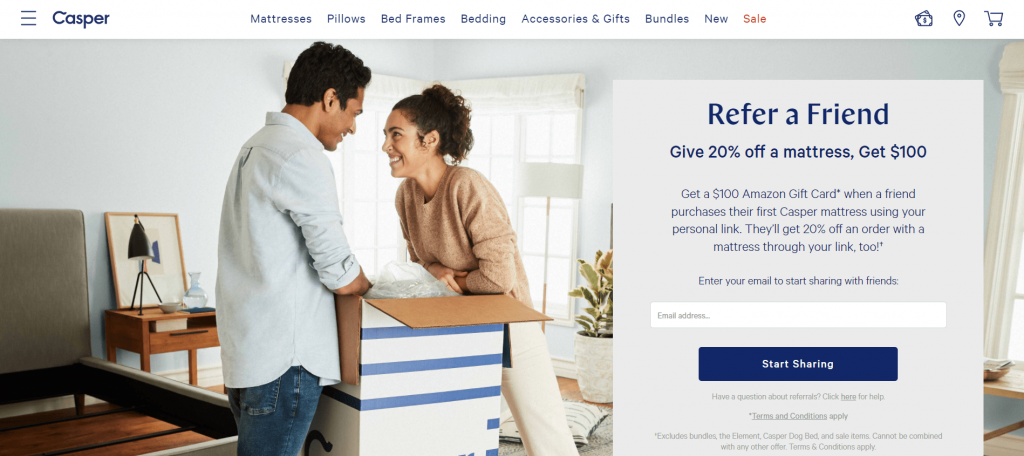
A referral process can be complicated to track since each member has a unique code or a link. Therefore, many companies use referral software to automate the flow, from generating links to sending rewards.
What Are the Benefits of a Referral Program?
Although this word-of-mouth marketing strategy requires a lot of investment, such as buying referral program software and offering rewards to incentivize customers, it is worth the effort. The referral program’s benefits include:
- Boosting sales. Over 90% of consumers trust recommendations from their family and friends, spending 200% more than regular buyers. Referral marketing is so effective because it replicates the feeling of a trusted friend’s recommendation.
- Building brand awareness. Many active referral program members indicate more people will talk about your brand.
- Increasing customer retention. A brand can award loyal customers for generating new leads through a referral program, resulting in a better relationship with them. Moreover, referred leads also have a 16% higher lifetime value than people from other marketing channels.
- Reducing customer acquisition costs. About 54% of marketers agree that referral programs have a lower cost per lead than other platforms. The incentives prepared by a company help encourage existing customers to invite as many referrals as they can.
5 Great Referral Program Examples with Takeaways and Tips
Before you learn how to create your own referral programs, let’s look at the five best referral program examples for your inspiration.
1. Marriott Hotel
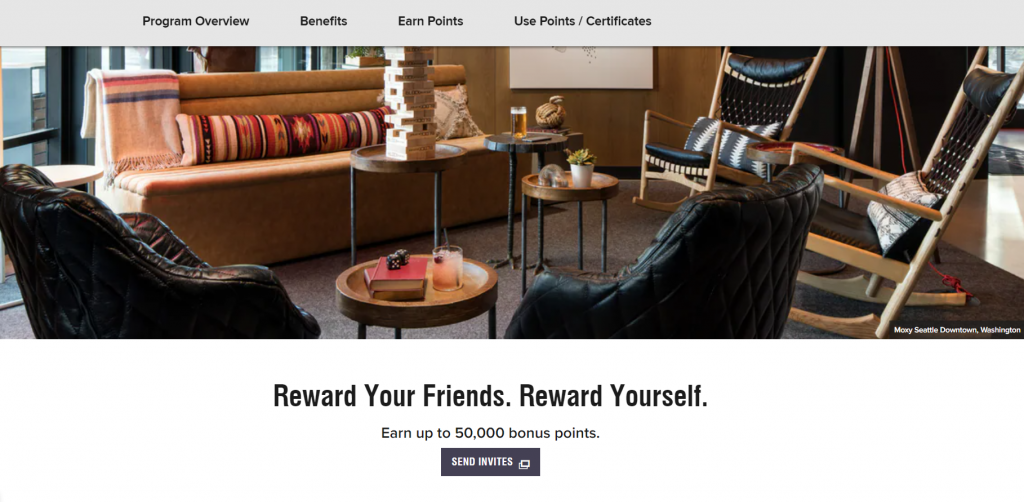
One of the excellent referral program examples comes from Marriott Hotel. This service-based business gives the existing customers points for bringing new customers. They can then redeem the points for referral awards, such as airline tickets and air rentals.
Key takeaway: instead of cash discounts, use point-based referral bonuses to encourage customers to return to your brand.
Marriott Hotel customers can earn at least 2,000 bonus points for each referral, but it is only possible to redeem those points for certain bonuses after reaching a specific number. For example, the company offers car rentals and flights for 10,000 points.
2. Girlfriend Collective
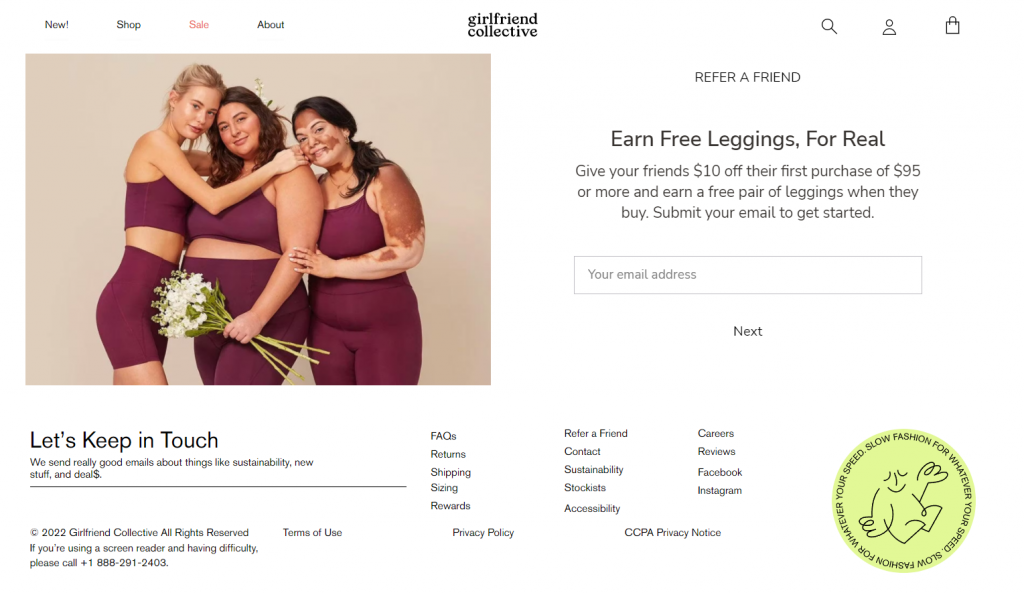
Girlfriend Collective is a sustainable activewear brand. Its refer-a-friend program provides the successful referral with a $10 discount, while the referring customer gets a free pair of leggings.
Key takeaway: encourage people to join your referral program with a free product. It’s a powerful marketing tactic since consumers are more likely to comply when a business involves free items. Tagging a freebie as a bonus also improves the perceived value of a product.
In this referral program, not only does Girlfriend Collective makes use of free products, but it also leverages its leggings’ popularity. This strategy helps ensure the free product quality is worth the promise and attracts more friend referrals.
3. Hostinger
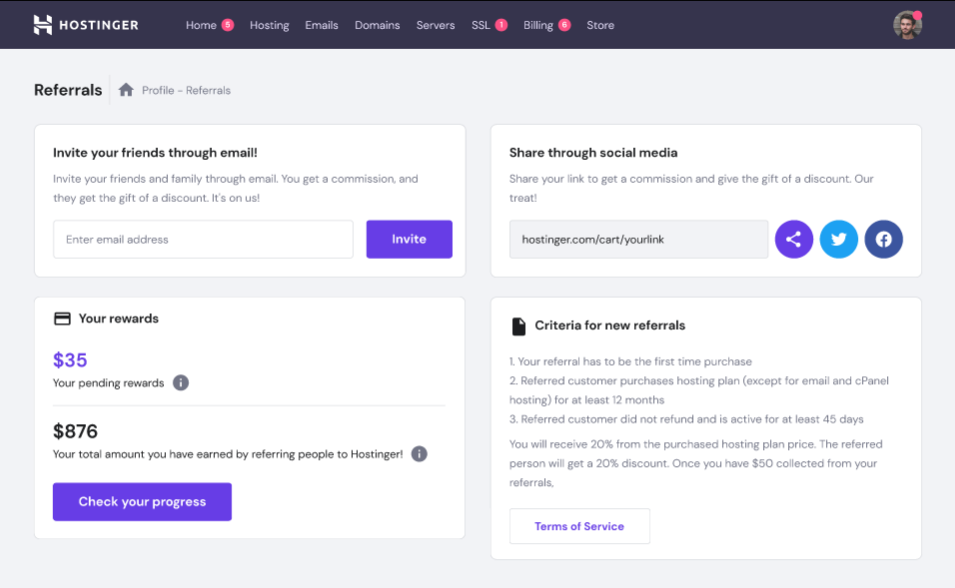
Hostinger is a web hosting company that offers numerous services, from shared cheap web hosting services to VPS solutions.
Hostinger’s referral program lets existing users offer 20% discounts on Hostinger products to the referred customers. For each purchase made by a referred customer, the referrer will receive up to a 20% reward. Users can sign up and manage their referrals through hPanel, Hostinger’s hosting control panel.
Key takeaway: make your referral program page as user-friendly and feature-rich as possible. Seamlessly integrating it into your product and incorporating helpful features will enhance the referrers’ overall user experience.
Since Hostinger’s referral program page is easily accessible through hPanel, the signup process is quick and straightforward. Managing referrals is also easy with the included features, such as referral progress tracking and the option to connect to multiple PayPal accounts.
4. Tesla
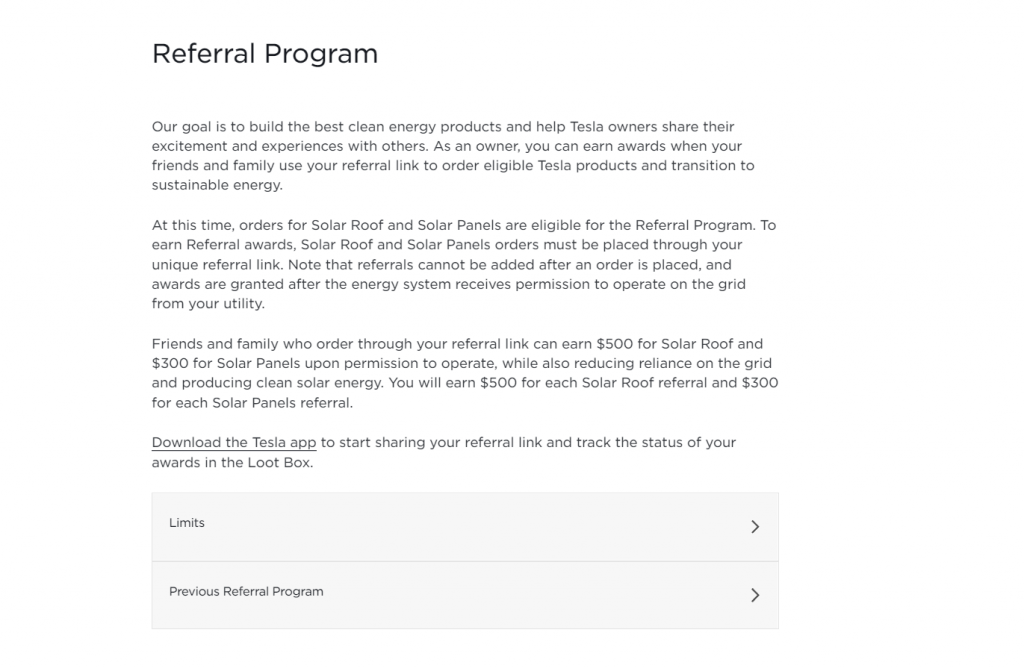
Throughout the years, Tesla’s referral program has changed its bonus system. The company now gives free Supercharging miles for the referred leads and offers various rewards for the referrers, from a free car to a company tour.
Key takeaway: consider experimenting with different rewards or bonuses. It will help find the right referral program incentive and surprise the audience.
Note that it’s essential to inform your customers to avoid confusion and build excitement. For this reason, Tesla’s referral program page shows the previous and ongoing referral campaigns. Its referral bonuses are also unique, like watching a rocket launch and joining its test track.
5. Getaround
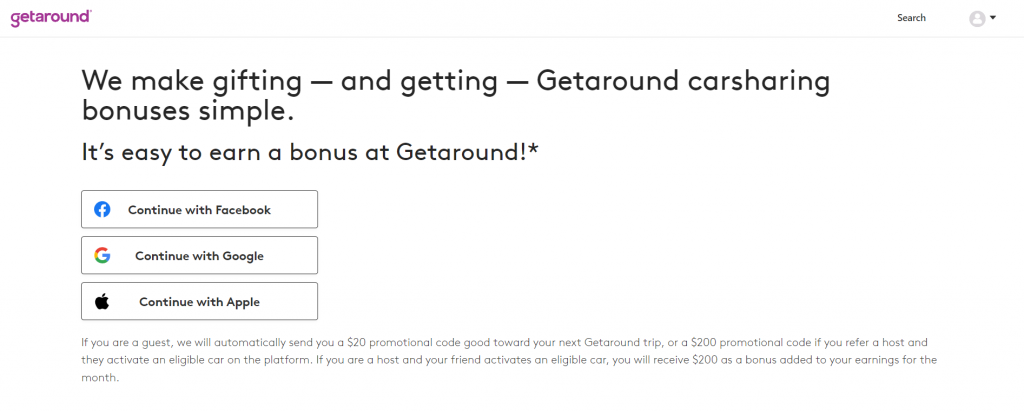
Getaround is a car-renting marketplace. Referring customers will get driving credits if their friends take their first trips and earn cash when new customers lend a car.
Key takeaway: provide a social sign-in method for current and new customers. Social logins don’t require users to make and keep track of more credentials, reducing login failures and password fatigue. In fact, creating new accounts on websites bothers over 80% of users.
Getaround makes it easy to join the referral program by providing three popular social login options – Facebook, Google, and Apple.
How to Create a Referral Program
Now that we have explained the concept, benefits, and examples of referral marketing programs, go ahead and follow these six steps below to set up yours.
1. Define Your Perfect Customer
A referral program works when a business gets referrals that buy your products. However, it can be challenging for your current customers to understand what a good referral is.
Therefore, identify your ideal buyer before asking your current customers to find referrals. Once you decide on it, share the information with them. That way, they will know who they should refer rather than just list friends’ names to collect the referral marketing program’s bonuses.
The perfect referred customer description does not have to be long. For example, a copy like “Your friends love running? Give them $30 off their first order.” is suitable for a running shoes company since it indicates that you target running enthusiasts.
Defining a perfect customer also helps find the right advocates because not all customers want to join the referral program.
We recommend applying the Net Promoter Score (NPS) approach to decide which customers to ask for referrals. This method scores customers’ satisfaction with your business from 1 to 10 and categorizes them into:
- Promoter. People who score 9 to 10 are likely to recommend your products.
- Passive. Customers who are not likely to recommend but they do not give poor reviews either.
- Detractor. People who share negative reviews.
When promoting your referral program, engage with the Promoter as they are the best customers for the referral lead generation.
Expert Tip
The most common type of customer who participates in referral programs is an early adopter. This means that they tend to be ahead of the curve when it comes to new technologies and trends.
They’re also often referred to as influencers as they tend to be active on social media like Instagram and Snapchat and have large networks of friends and acquaintances. If you’re trying to get people excited about your referral program, you should try targeting these kinds of customers.
Moreover, people who have tried a product and loved it, and those who have been delighted by the customer service at a company are also likely to participate in a referral program.
2. Come Up With Valuable Rewards
Over 70% of consumers value brands that offer incentives. Giving them bonuses provides additional value and makes the brand experience memorable.
To develop a perfect reward system, decide who will get the reward first. There are three ways to do this:
- One-sided incentives for existing customers. This option helps improve customer retention, but it may not encourage new customers to join. It’s best for companies selling affordable products as the referred friend may be still interested in buying them even without discounts.
- One-sided incentives for referred customers. It helps motivate new customers to purchase. However, the number of referrals may be lower since the referrers may not be interested in joining.
- Two-sided incentives. This strategy rewards current and new customers, motivating them to join the referral program. However, not all businesses can afford to provide incentives for both parties.
Although referral benefits may effectively attract leads, brands should calculate them carefully to keep the budget intact. To do this, set some requirements for customers to get the rewards.
Take a look at Rothy’s refer-a-friend program. The fashion brand’s referral reward is valid only if the new customers purchase a product over $50. It also expires 30 days after the existing customer’s share, giving a sense of urgency.
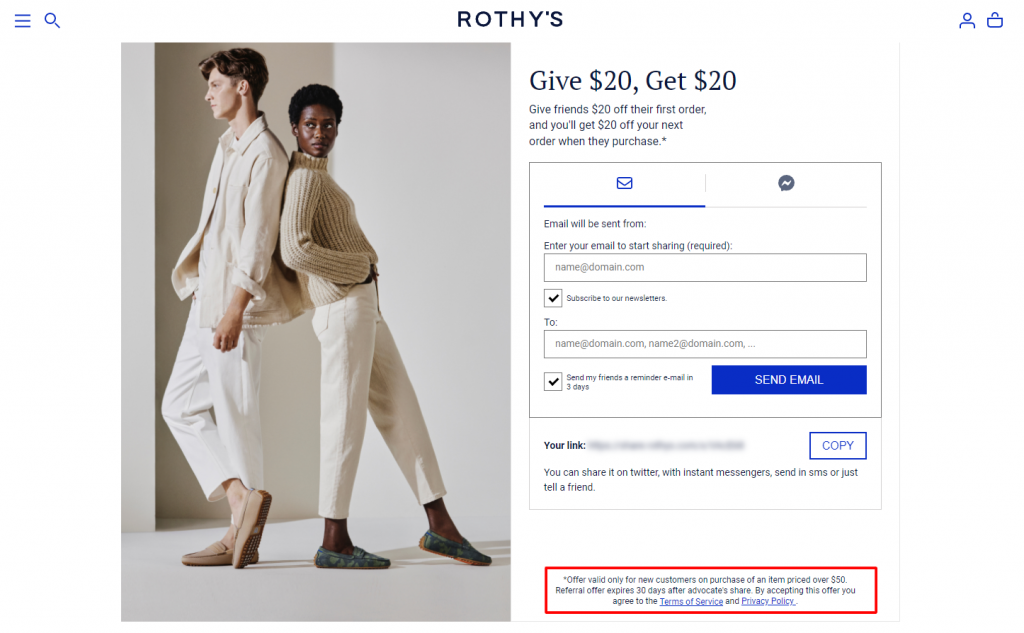
Expert Tip
You need to pay attention to your KPI’s, your cost/product or service, and the approximate lifetime value of each of your customers.
An easy tip is to look at your current cost/client then take that number and multiply it by the number of new customers you are hoping to get from the referral program.
Then as you deploy the campaign, you have a pre-set budget that is in line with what you would be spending for clients through traditional marketing. Depending on how the campaign does, you can decide if you need to alter it over time.
After choosing the rewarding method, it’s time to determine what to offer.
Consider what your customers value the most and whether you’ll offer monetary rewards. Monetary incentives may sound enticing, but they’re not the only option. For example, a beauty brand can give a make-up consultation instead of a free product.
We’ve listed some types of incentives for your inspiration:
- Cash
- Discounts or coupons
- Free products
- Company merchandise
- Service upgrades
- Free subscriptions
- Gift cards
- Donations to charity
- Behind-the-scenes tours
Consider asking current customers if you’re unsure what to offer for the referral marketing program.
To do so, use polling and Q&A features on social media to ask for their preferred bonus.
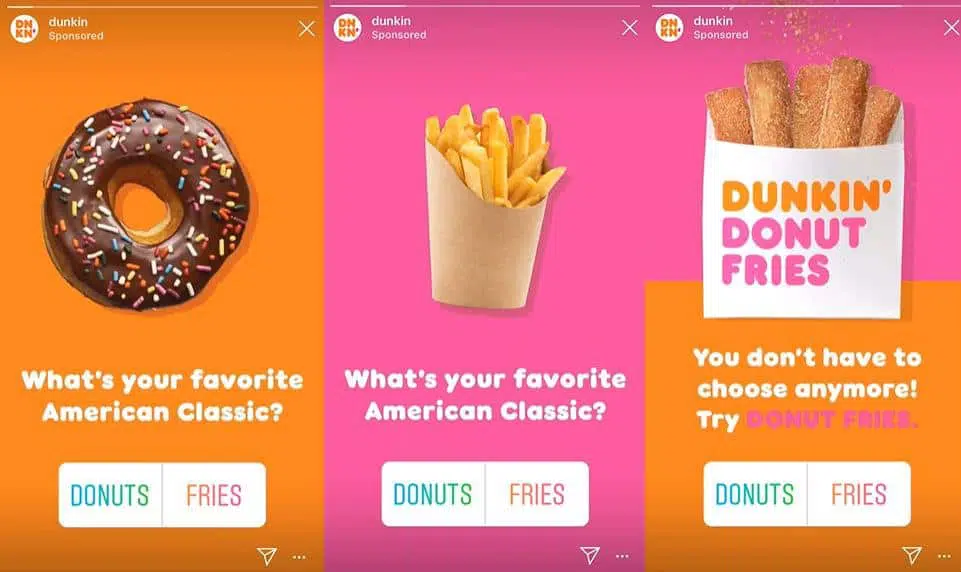
Alternatively, conduct a customer survey by sending them questionnaires. Use tools like Google Forms and Typeform to gather and analyze customers’ answers. Moreover, these tools provide premade templates for customer surveys and let you create custom ones from scratch.
3. Choose a Referral Program Software and Set It Up
The referral process is too complicated to be done manually. Therefore, invest in a referral marketing tool to keep track of successful referrals, rewards, and how much you earn from the campaign.
Here are our top three referral marketing software tools with their pricing plans, pros, and cons.
1. Viral Loops
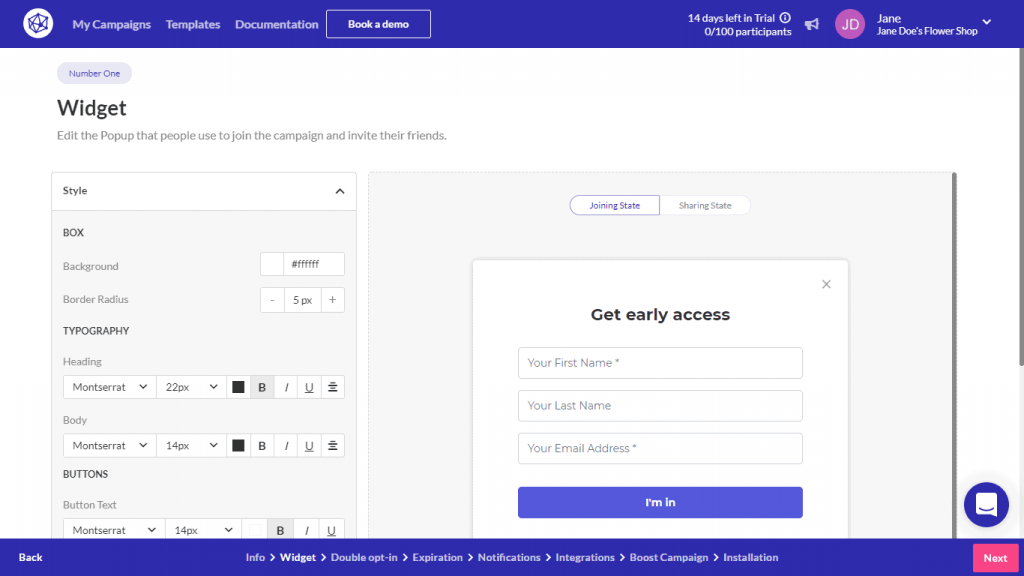
Viral Loops is available for various website-building platforms, like WordPress, Squarespace, and Shopify.
This referral software is one of the best referral marketing tools with affordable prices. It comes with several monthly pricing plans ranging from $34 to $208.
Pros:
- Ready-made landing pages for businesses with no websites.
- Real-time dashboard to see how many referrals per participant and who awaits bonuses or commits fraud.
- Complete integration with different kinds of platforms, like website builders, customer relationship management (CRM) software, and messaging apps.
Cons:
- Enforced Viral Loops branding on the two cheapest pricing plans.
2. ReferralCandy
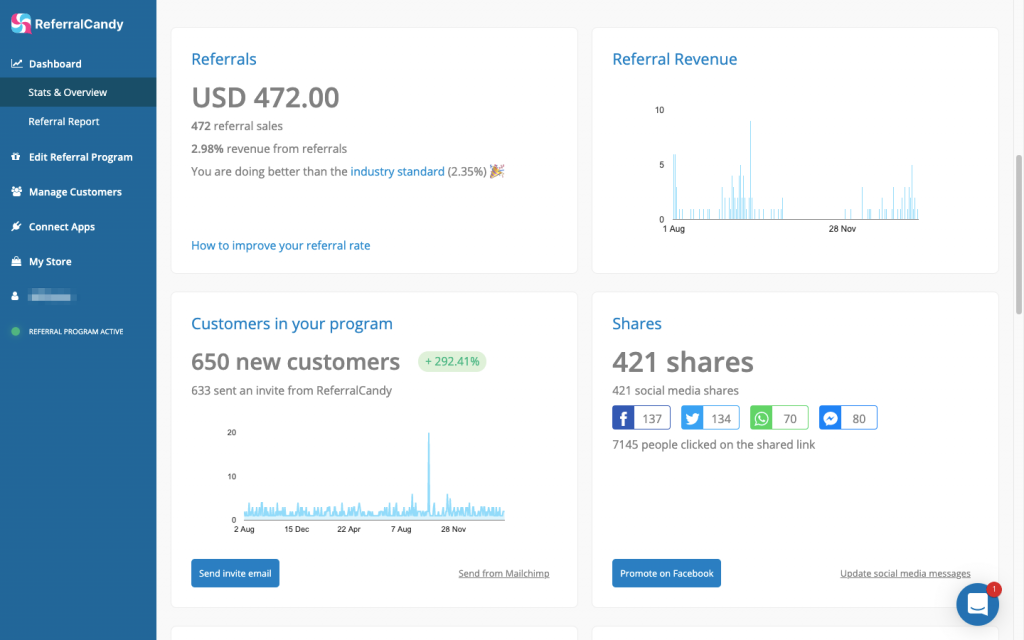
The process of setting up ReferralCandy will depend on your eCommerce platform.
If you use WooCommerce, you only need to install the plugin and configure the settings from the WordPress dashboard. Other platform users may need to sign up via its website.
This referral marketing platform offers two pricing plans, Premium for $49/month plus commission based on your monthly sales and Enterprise for $3,999/month.
Pros:
- Total control over the designs with HTML and CSS editing.
- Automation features, such as sending referral invitations, distributing rewards, and tracking fraud.
- Various integrations with email marketing and eCommerce platforms, like WooCommerce, Shopify, and BigCommerce.
Cons:
- The inability to make multiple codes or individual rewards.
3. Referral Factory
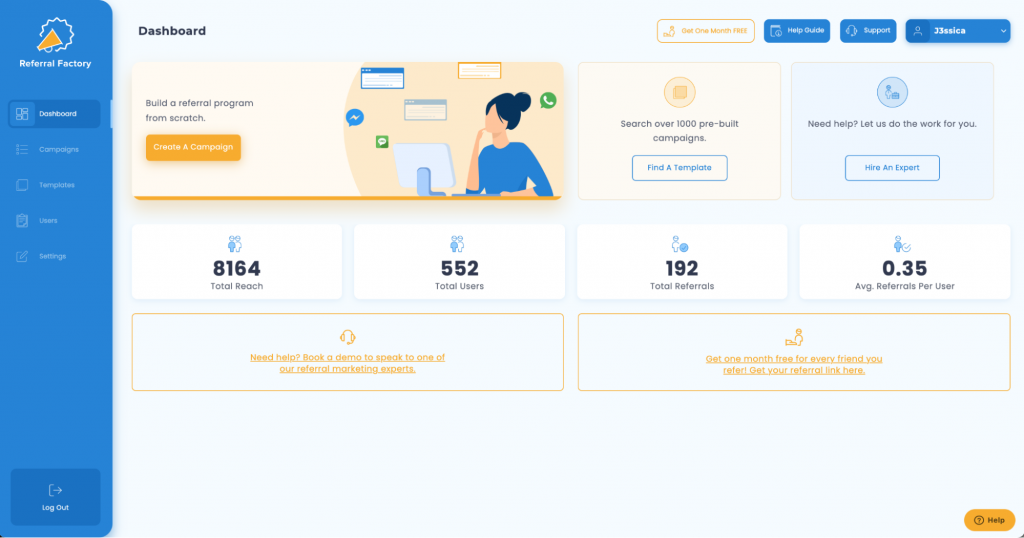
Referral Factory lets marketers create, manage, and track their customer referral programs easily. Sign up to its website, and you’ll land on the dashboard to customize the referral message, access the referral list, and connect to your Facebook pixel or Google Analytics ID.
This referral marketing software offers a 15-day free trial with a paid plan starting from $95/month.
Pros:
- A drag-and-drop builder with 1000+ referral program templates.
- Integrations with various channels.
- Flexible factory API.
Cons:
- The most expensive option compared to the previous ones.
4. Design Your Referral Program
Before marketing your referral program, it’s essential to plan and design it carefully.
Here are several elements to consider when designing a referral program:
- Rules and eligibility criteria. Make the requirements simple to attract customers to join the program.
- Workflow. Decide the sign-up methods, the use of a referral link or a code, and a referral payment.
- Referral messages. Keep the referral messaging clear by explaining the offer and providing a call to action (CTA) to share the code or link.
- Referral invitation. It refers to the message sent by your customers to their friends. In this invitation, make sure to introduce your brand and program as their friends may not know your business. You can use the referral program software templates or let customers create and edit their own.
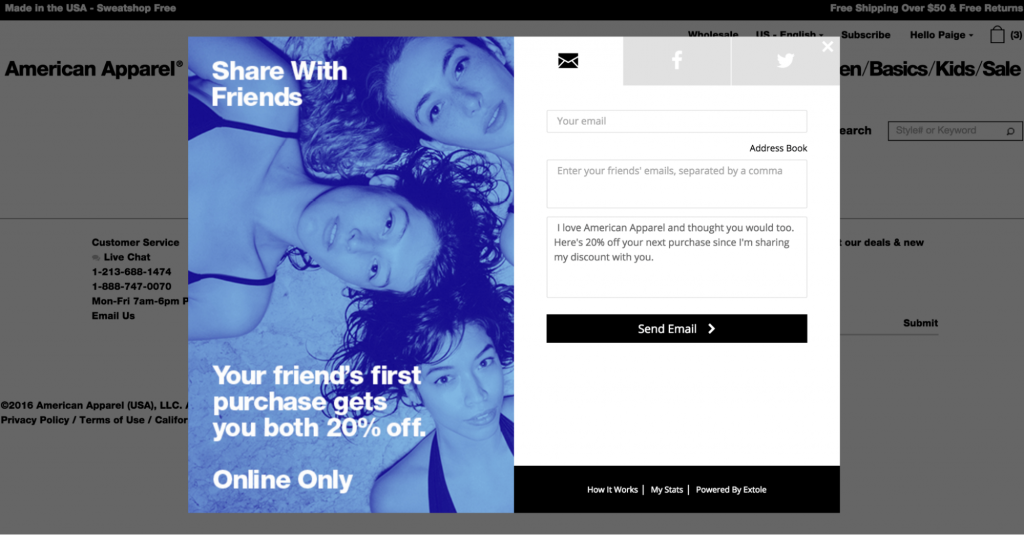
Set up these elements on your referral program software, and include the information above in your website for transparency. Use a catchy headline to grab people’s attention and explain the benefits of joining the referral program.
If you want to keep the referral program page simple, consider placing a link to your Help or FAQ page and describing the terms and conditions there.
Riff Raff & Co is an excellent example of this practice.
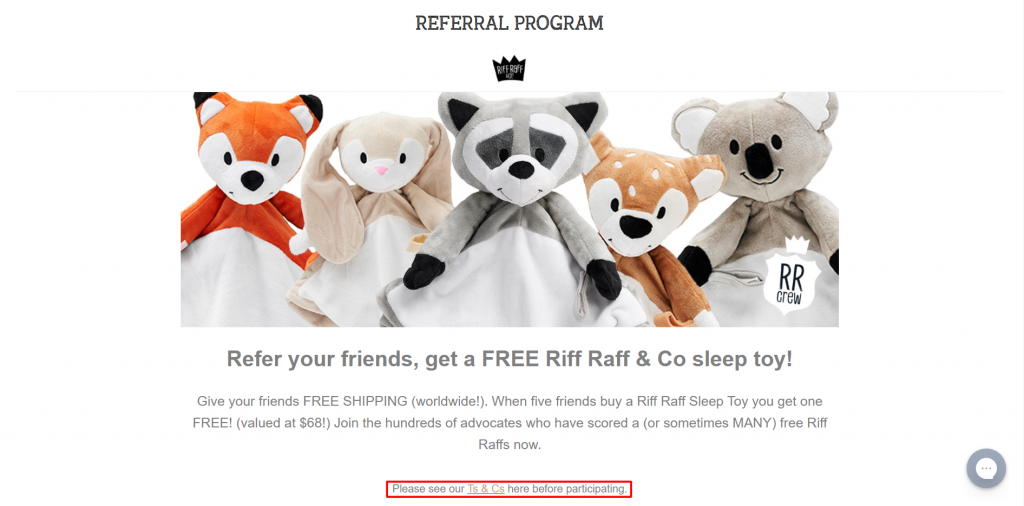
Its referral program’s landing page only contains short descriptions of how it works. It also explains the details on its term and condition page, including what a referral code is, how to refer friends, and referral award options.
A referral campaign page may be the first touchpoint for new leads, so consider displaying reviews. This helps convince them to purchase products as 89% of people read reviews before buying items. Display user-generated content or embed a review site widget like TrustPilot or Yelp.
Once the design is complete, test the referral flow. Check whether the link or code works, and the instructions are easy to follow. Consider asking other people to try it and proofread the information to gain third-party feedback.
Expert Tip
You’ll want to make sure that:
• Your referral program policy has no loopholes.
• The forms on your pages work properly.
• Referrals are tracked and triggered properly.
• Your automated emails don’t have any issues.
• Your social sharing links are all working.
• All the required JavaScript appear on the correct pages.
• If you’re using any integrations, those workflows are working as planned.
5. Market the Referral Program
After testing the process, it’s time to market your new rewards program to loyal customers.
We’ve listed six practical ways to promote your referral program:
- Showcase the program on the website. Place the referral program link on prominent places on your website, like its homepage, an announcement bar, or a pop-up message.
- Get employees involved. Ask them to include the referral program’s link in email signatures, especially for those often interacting with customers over emails.
- Highlight the program in the packaging. Leverage the unboxing trend and excitement by including the referral bonus program in the package or inserting a brochure with a referral code.
- Share the program on social media. Design a custom image or use paid ads to promote the referral program on social media.
- Work with influencers. Find influencers among your happy customers and ask them to promote your brand to their following. With this method, you may need to offer an additional bonus to make them endorse you.
- Use email marketing. Send emails to all existing customers or those who have the highest NPS scores, and entice them to be the brand advocates. You can automate the email flow by sending it on the invoice and several weeks after the purchase as they have used it for a while.
After customers sign up for the referral program, it’s essential to periodically remind them about it to keep them active and engaged.
Some opportunities to re-engage brand advocates are:
- When a customer has not sent a referral yet after several weeks of joining.
- Whenever an existing customer shares a positive experience online.
- Once a new person signs up or purchases from the referral link.
Expert Tip
One of the best ways to make sure your customer participates in your referral program is to launch the program on a pop-up page right after the customer checks out.
The copy should be clear about how to refer your business to their friends and what benefit the customer and their friends would get out of it.
6. Analyze and Perfect Your Referral Program
The process does not end after you promote the referral program – you need to analyze the campaign performance.
Campaign analysis helps you understand what aspects have worked well. It also uncovers how the customers respond to your referral program.
These are four referral marketing metrics and how to improve them:
- The number of participants. See how many people join the referral program and actively share their codes. If you see that the number is dropping, perform A/B testing to know which CTA placement attracts people the most to join. You may also need to review the effectiveness of the promotion strategies.
- Recipient clickthrough and conversion rates. Check the number of referrals that click the link and buy your product. To improve this metric, consider looking at the referral invitation. You may need to change the design, wording, or reward to attract the recipients.
- Churn rate. It refers to the percentage of people who stop joining the program. A high churn rate often indicates that customers are excited about joining but not staying. That’s why re-engaging with participants is essential. Other than reminding them about the program, you can also provide content on how to get referrals.
- Sales. Track new sales from referrals and notice the referral sources that drive most sales.
At this point, installing a referral marketing platform is indispensable as it helps track the metrics automatically.
For instance, Referral Candy provides insights on sales, traffic, and customers. Moreover, it displays social mentions and lets businesses compare their referral rates with the industry benchmark. Since every referral link is personalized, this tool also shows each customer’s referrals.
To gain quality measurement, consider sending a feedback survey to the participants to see what they think about the referral program.
A rule of thumb is to create a short survey.
45% of people are willing to spend five minutes at most on a feedback survey, but the number drops by 12% if they have to spend up to 10 minutes. It is also important to be clear with the questions as 40% of consumers give inaccurate answers to confusing questions, resulting in unreliable data.
Bonus: Ideas for Customer Referral Programs
Let’s take a look at five referral program ideas to motivate customers to join your word-of-mouth campaign.
1. Referral Contest
Generally, referral contests incentivize participants after achieving a particular number of referrals. You can also give a bonus only to a customer of the month – the one referring the most people during the contest.
A contest is a great idea to increase leads. It encourages customers to share their referral links and invite as many friends as possible. The contest’s strict time frame also builds a sense of urgency.

The drawback of this strategy is the quality of leads. Customers may randomly invite their friends, and you won’t get qualified leads.
To create a contest providing high-quality leads, consider basing the winners on conversions rather than the number of referrals. In this case, you can define a successful referral as someone who signs up for the email list or purchases a product.
2. Tiered Reward Structure
Encouraging customers with a discount or a cashback reward is an effective way to increase referrals. However, they may be more motivated if the referral awards improve as they contribute more.
A tiered reward system works by motivating participants to step up in the referral program and gain more significant benefits for inviting more people.
Take a look at how Morning Brew sets its tiered referral program. The reward starts from a free premium Sunday newsletter for three referrals to a trip to its headquarter for 1000 referrals.
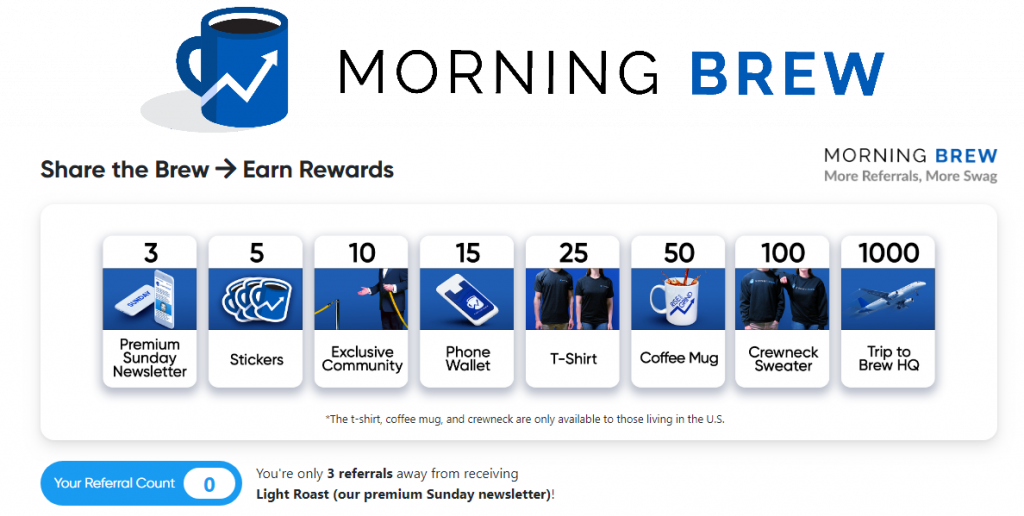
Alternatively, tier the referral campaigns based on products. For example, the referrers get a 5% discount when their friends buy your low-priced products and a 25% for the most expensive ones.
3. Stacking Rewards
This referral program combines discounts for every referral a customer gets.
For example, a customer gets 10% off of a gym subscription if they invite a friend, and the discounts are multiplied if they refer more people. As a result, the customer won’t have to pay for the membership by asking ten new customers.
To ensure you and customers gain benefits, create a rule that the rewards are applicable if the referring and referred customers are active. This helps you keep the cash flow and customers happy.
Therefore, this strategy is suitable for a subscription-based service or product for businesses like:
- Children’s classes, e.g., swim or gymnastics lessons
- Gyms
- Salons and spas
- Meal-kit providers
4. Partnership
Referral partners will recommend your product or service to their loyal customers in exchange for rewards, or vice versa. This partnership provides you with lead opportunities and connects with like-minded business owners.
Let’s say your product is healthy food delivery meals. You can partner with a yoga studio by discounting its existing customers and giving your loyal customers a free yoga class.
You can also collaborate with a local charity organization and donate for every new referral, or you give a free product to the devoted donors.
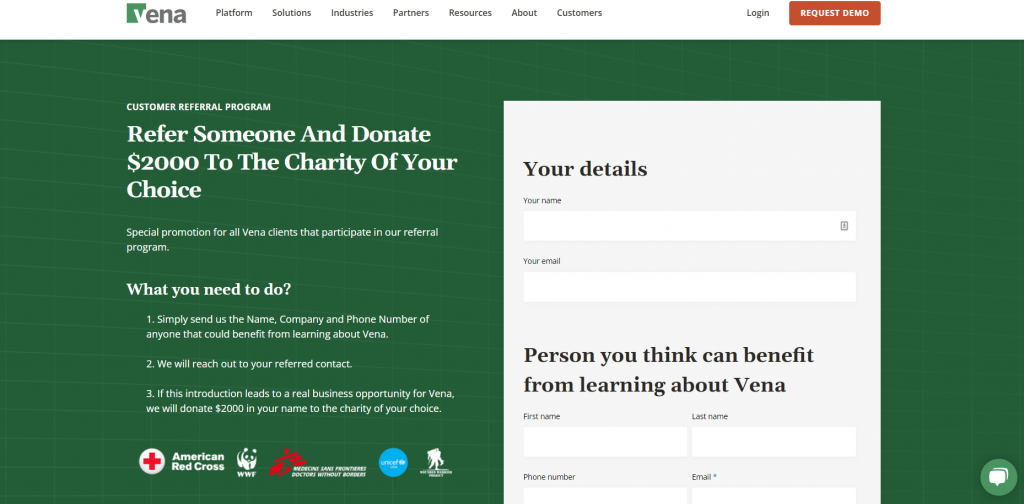
Before choosing a partner, ensure that they have similar values and audiences to encourage referrals that fit each other’s products or services. Then, create a partnership agreement to set guidelines and avoid disputes in the future.
5. Free Information
Another great way to motivate consumers to join the campaign is to give them free information for referring your brand to their friends. This incentive includes workshops, training, or courses.
Just make sure that the information is relevant and worth the action.
Get Response is an excellent example of this idea. This inbound marketing software company gives the existing customer a free digital marketing certification course for three friends joining the paid account. This course helps participants gain online marketing knowledge and save money.
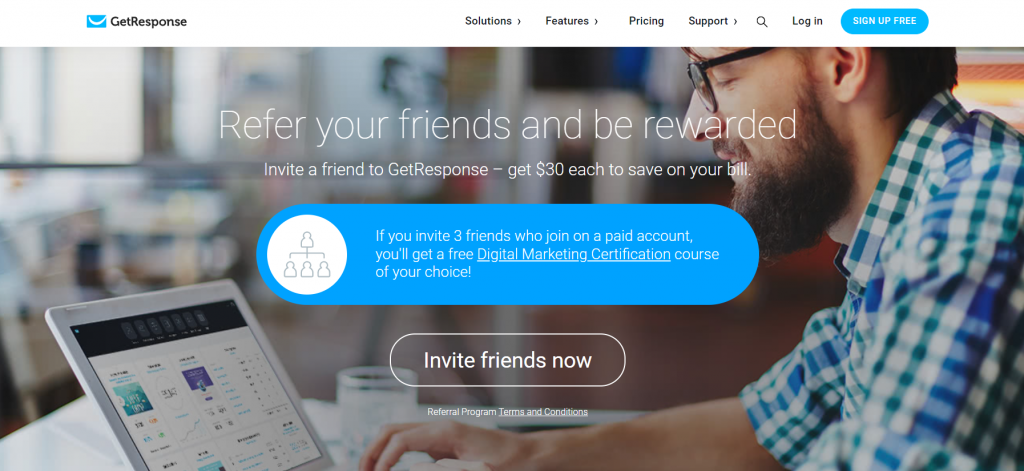
Conclusion
Referral marketing gives existing customers incentives for recommending products or services to their friends via unique links or codes. In return, they receive bonuses, such as discounts, free products, and company swag.
Besides attracting new people, referral programs help improve customer engagement, lower customer acquisition costs, and increase sales.
Many famous brands have unique approaches in applying this word-of-mouth strategy. For instance, Mariott Hotel uses a point-based reward system, while Hostinger allows everything to be managed from one convenient place such as hPanel.
Here are six practical steps on how to create a referral program:
- Define your ideal customer and share it on your referral program page.
- Determine the referral incentives.
- Pick and set up your referral program software.
- Plan the program requirements and flow.
- Promote the referral program to your marketing channels.
- Analyze and tweak the campaign.
Consider offering a tiered reward system or holding a referral contest to make the program more attractive. Other alternatives are partnering with like-minded businesses or giving a free course to customers.
If you’re planning to start a website to support your business, make sure to pick a quality web hosting company to improve your site performance and user experience.
Referral Program FAQ
This section will answer three common questions about building your own referral program.
What Is the Difference Between Referral vs. Affiliate?
Referral programs reward customers for inviting their friends to purchase products or services. Affiliate marketing programs, on the other hand, compensate third-party advocates, like influencers and bloggers, to recommend brands.
When Should I Start a Referral Program?
Most businesses launch referral programs when they have built a loyal customer base. A referral program is also helpful to generate buzz during the pre-launch as a marketing tool.
How Much Should I Pay For Customer Referrals?
The number will depend on your reward system – discounts, cash, or points. Generally, brands give the existing customers 10% to 25% off or money for their friends’ first purchase. Then, they offer the same or less amount of bonuses to the new leads.




